Metropolitan Avenue, 1976 – Photo by Middle Village artist Doug Leblang
By CHRISTINA WILKINSON
Forgotten NY correspondent
THE Williamsburgh-Jamaica Turnpike was completed in 1814 and operated as a toll road between the towns of Williams-burgh in Brooklyn and Jamaica in Queens, two major centers of trade in the 17th, 18th and 19th centuries.
By 1820, the part of Newtown best known for its 100-acre swamp was being called ‘Middle Village’ because it lay midpoint on this road.
Its growth hampered by the presence of the large swamp, Middle Village found itself in a strange combination of niches – it became renowned as both a stagecoach stop and a place to bury the dead.

(This 1873 map of Middle Village was taken from the larger map of Newtown found on the Brooklyn Genealogy Information Page.)
The Turnpike became Metropolitan Avenue, a free road, by 1873. The western part of Middle Village which today borders Ridgewood was also called “Metropolitan” prior to WWI, but it is unclear whether the avenue named Metropolitan or the community named Metropolitan came first.
Let’s wax retro down Metro…
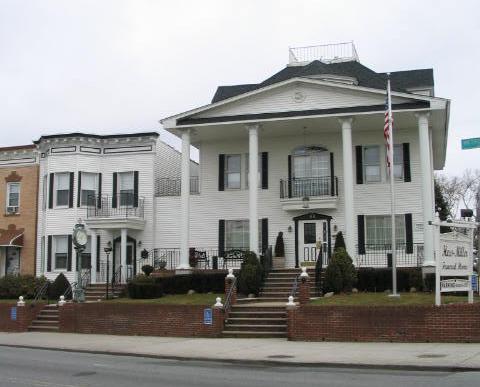
Hess-Miller Funeral Home
This building dates from 1902 and was originally the summer home of a local politician. In 1920, John Miller purchased the home and established his funeral parlor here. When Arthur Hess partnered with him in the 1940’s, it then became the Hess-Miller Funeral Home. It is still in business under the same name, although it is no longer owned by either family.
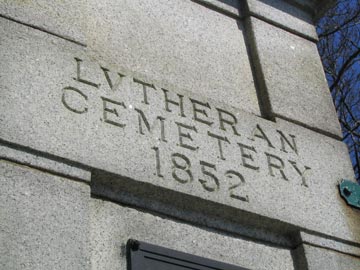

Lutheran-All Faiths Cemetery
A law was passed in 1847 that banned future cemeteries from being opened in Manhattan. As a result, Lutheran Cemetery was founded in Middle Village in 1852 by German churches located in Kleindeutschland, Manhattan. Many of the victims of the General Slocum tragedy were laid to rest here. A monument dedicated in their honor at which an annual memorial ceremony takes place is found within the confines of the cemetery’s southern portion.
![]() General Slocum monument at Lutheran-All Faiths can be seen on the FNY North Brother Island page.
General Slocum monument at Lutheran-All Faiths can be seen on the FNY North Brother Island page.
Today, the cemetery is open to people of all faiths, and has been renamed to reflect that fact. For now, German Lutherans remain the predominate group interred here. The NYS Division of Cemeteries bestowed upon the cemetery the distinction of being “exceptionally well operated and maintained.” Lutheran-All Faiths Cemetery is bisected by Metropolitan Avenue, and the New York Connecting Railroad tunnels under a portion of it.
Scenes from Lutheran-All Faiths Cemetery
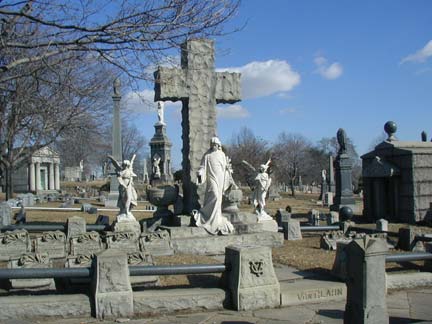
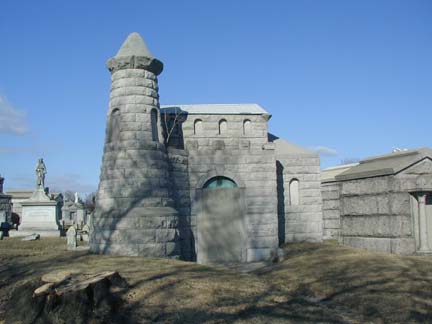
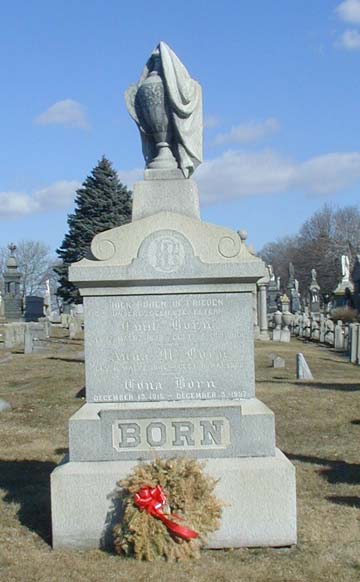
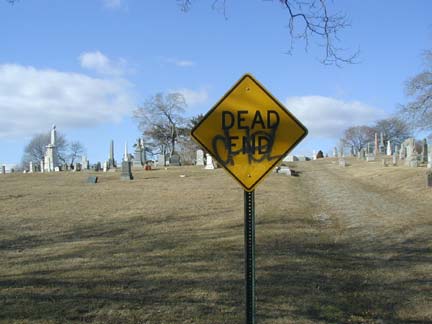
Fresh Pond Crematory
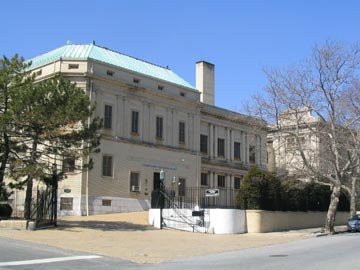
The landmark Fresh Pond Crematory and Columbarium has been in business since 1893.
[The building is actually off of Metropolitan Avenue, on Mount Olivet Crescent.]
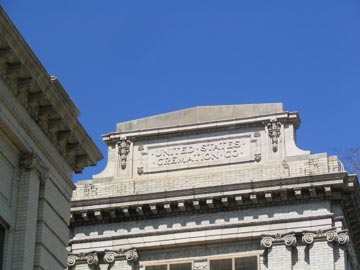
Baseball legend Lou Gehrig, screenwriter Ring Lardner, Sr. and Titanic survivor Fredrick Seward are among those whose remains were reduced to ashes here.
Christ the King High School
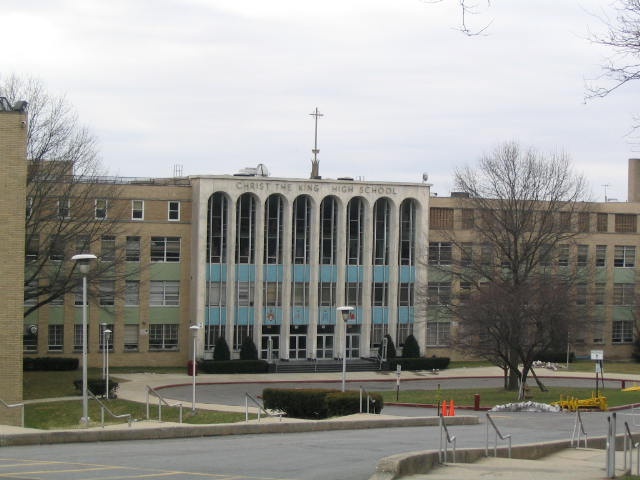
Co-ed Christ the King Regional High Schoolopened in 1962. WNBA player Chamique Holdsclaw is an alumna.
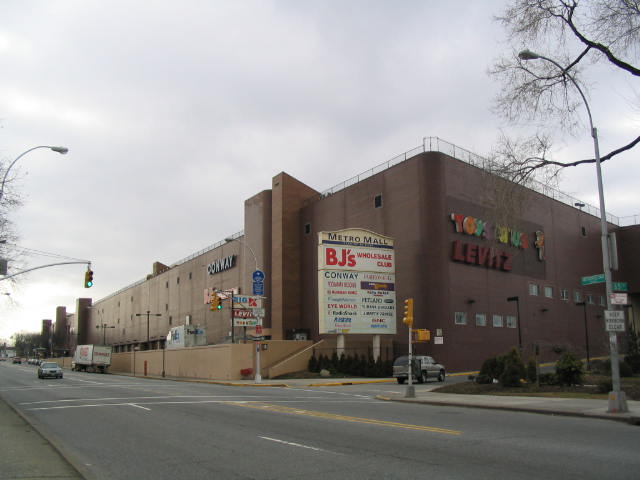
The site of the behemoth that is the Metro Mall(BJ’s, Big K, Toys ‘R Us and Levitz are among its tenants) actually has a pretty interesting history.
The M train

The Myrtle Avenue subway line replaced a former horsecar route, the original purpose of which was to shuttle visitors between Lutheran Cemetery and Myrtle Avenue. This is what the line’s first el terminal looked like in 1906, back when you could ride all the way to Manhattan for just a nickel.
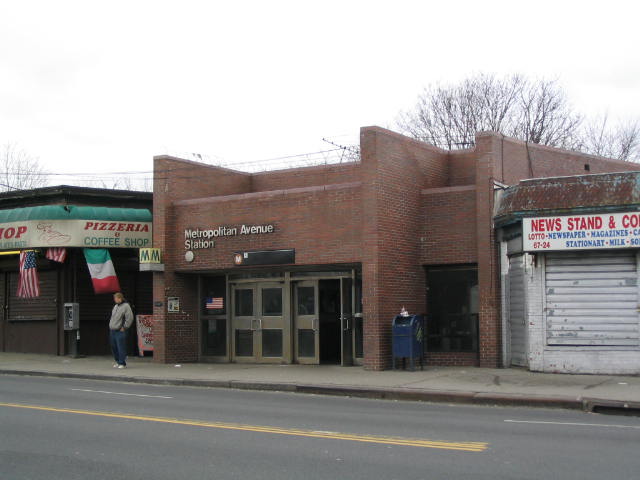
This is the modern-day M train terminal. Today’s inbound riders are more likely venturing to Christ the King or the Metro Mall than to the cemetery. Today the fare is $2, and half the time on the weekend one is forced to take an overcrowded shuttle bus just to get to Wyckoff Avenue…
Frank T. Lang Building
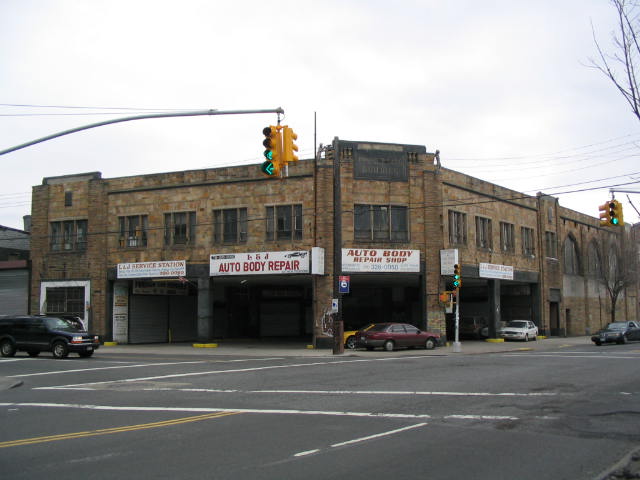
The Frank T. Lang Building at 69th Street was built by a mausoleum and monument manufacturer in 1904. Recently during renovations, a Bohack gasoline station sign was revealed there.
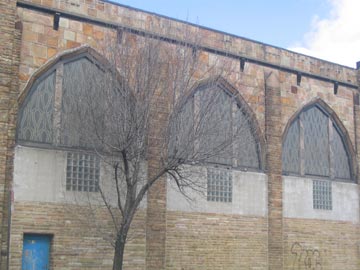
The gargoyles and carved faces along the top of the building were intricately detailed by artistic hands. Its cathedral windows are also quite unique. This building is a fine example of art deco architecture.
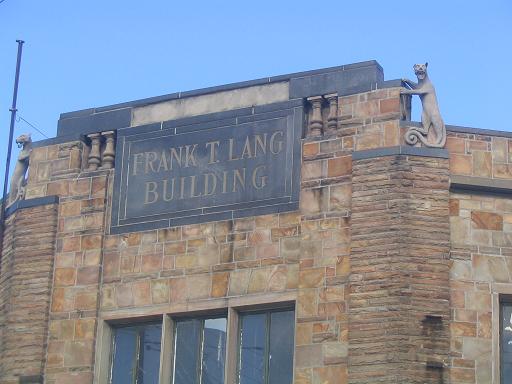
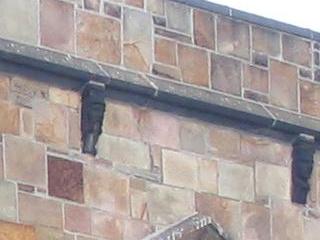
Building detail. (Are those lions? What cat has a tail like that? –your webmaster)
Forgotten Fan Peter Koenig:
Those long-tailed creatures on the Lang Building are indeed cats. My family owned a knitting mill on the second story (and also in the rear). The one-story wing (to your left when viewed from across Metropolitan Avenue) was occupied by another knitting mill. As a child, I was fascinated by the sculptures, and looked them over with a pair of binoculars. They also have big teeth! I don’t know their significance, if any. I was told that the building originally housed a monument works (gravestones) serving the local cemeteries. There was also a huge overhead trolley crane at the rear of the building, which was once used to move the stonework. I was not aware that the building (also) housed a funeral home, though it would be compatible with the location and the monument works.
Niederstein’s (RIP)
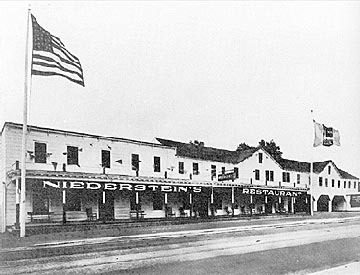
(info/photo from Queens Tribune/Queens Borough Public Library.)
Built by Henry Schumacher about 1854, this building became John Niederstein’s hotel andrestaurant in 1888. It originally served as a rest stop patronized by those hauling their goods between Jamaica and Williamsburgh via the turnpike. In the 1970’s the hotel was modernized by its new owners, who removed the porch and carriage sheds to make way for small parking lots. It ceased functioning as a hotel many years ago.
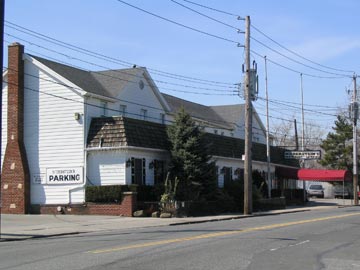
Niederstein’s Restaurant (April 2005). Niederstein’s served typical German fare and in recent years catered mainly to funeral and wedding parties as well as loyal locals. There was no joy in Midville when the restaurant closed in February of 2005 and was sold to a fast food franchisee. Arby’s eventually razed the building.
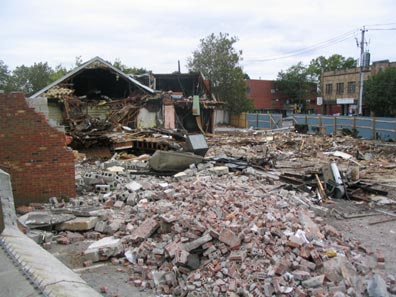
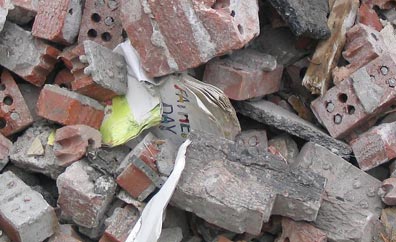
Niederstein’s was torn down as threatened by the fast food franchisee in September 2005. Robert Holden, president of the Juniper Park Civic Association, Inc. sent this letter to Jordan Krolick, Senior Vice President of Business Development at Arby’s LLC, who stated that “the community doesn’t seem opposed to it. In fact, they’ll be the first ones in here looking for coupons for free food.”
Mr. Krolick,
Unfortunately Niederstein’s was torn down yesterday (Friday). It was a sad day for Middle Village, Queens County and all of NYC.
Arby’s was insensitive, misleading, untruthful and we hold Arby’s responsible for destroying our beloved pre-Civil War landmark. The owner of the property, Tom Clarke told me he would at least save the old original wooden flagpoles. When I arrived at the site I was shocked to find both flagpoles destroyed and the demolition foreman said he had no directions whatsoever to save the flagpoles. Arby’s has shown a profit-only mentality and we will remind the entire community of Arbys’ insensitivity and unresponsive behavior on the issue.
I sent you an e-mail on Tuesday asking you to step in and use your influence to at least postpone demolition. You chose not to respond. Arby’s now has a much deserved negative reputation in the community and we will remind people of their total lack or respect for our neighborhood and its history. This community does not respond well to profit-only and heavy-handed business techniques. You and Mr. Clarke may find this out sooner than later.
Arion Theatre
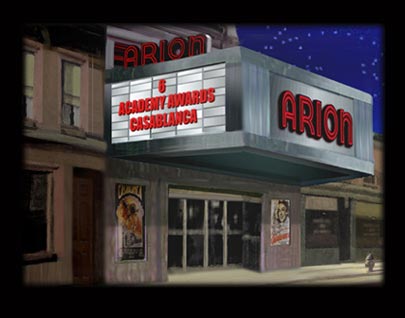
The Arion Theater, built in 1921, was the first theater in Queens to be wired for sound. This depiction of the theater as it looked in 1942 was painted by Middle Village artist Doug Leblang.
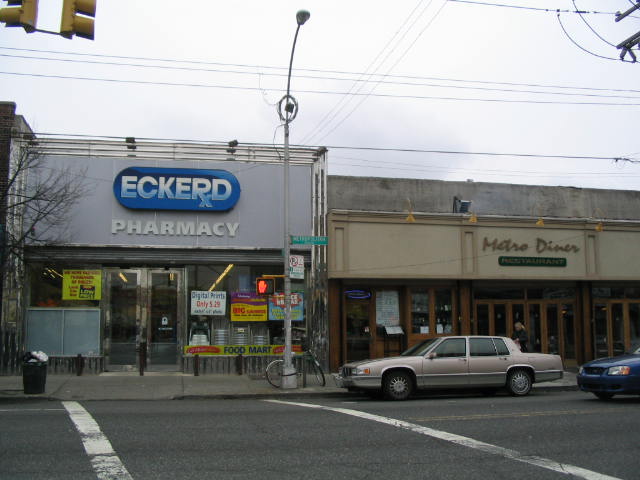
The Arion showed its last flick in the mid-1980’s. Most of the theater’s original structure is still there, but you would never be able to tell by its outward appearance. A pharmacy now occupies the building.
Methodist Episcopal Church of Newtown
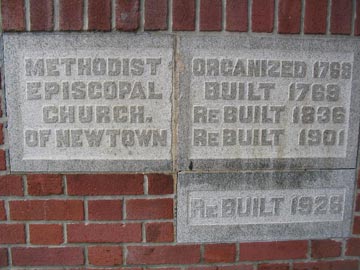
The first Methodist church in Middle Village was built in 1769 at the crossroads of what are today Dry Harbor and Juniper Valley Roads. It was originally called Methodist Episcopal Church of Newtown.
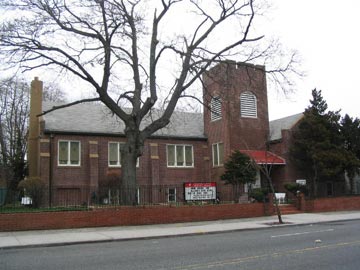
In 1836, after several disasters, the church was moved to its present site on Metropolitan Avenue. It was rebuilt a couple of more times since then, the last time being in 1926. Today, it is called United Community Methodist Church.
Artistic Building
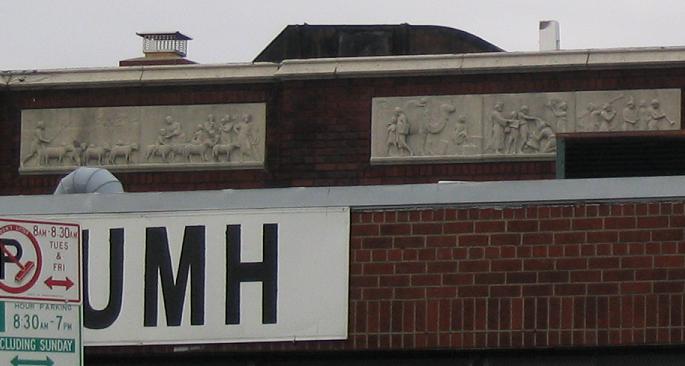
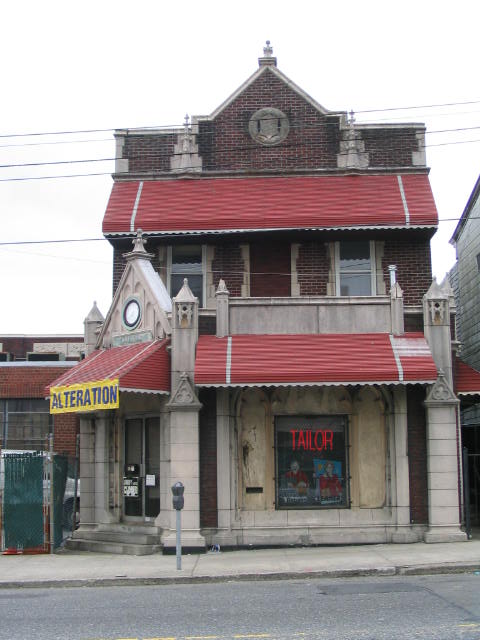
The elaborately detailed structure to the left was built in 1930 on Metropolitan Avenue. Signage above the entrance, half-hidden by the awning says, “Artistic Building.” Today, vinyl and neon announce alterations by a tailor, which most would agree is an art unto itself.
Next door to and behind the Artistic Building is a hidden wall (above) which features friezes of biblical scenes. What this building once was is a mystery, although given the area, it’s quite possible that it was either a floral shop or a monument company.
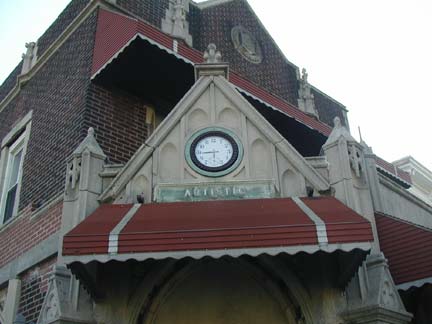
St. John Cemetery
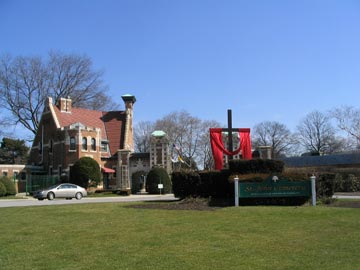
Yes, yet another cemetery! Sorry to be so focused on death, but you just can’t escape it here in Middle Village… Just as it does through Lutheran Cemetery, Metropolitan Avenue runs right through the heart of St. John Cemetery.
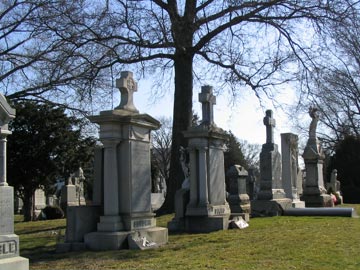
The Catholic Church opened St. John in 1880. Today, it’s the city’s best known mobster burial ground. However, artist Robert Mapplethorpe, bodybuilder Charles Atlas, and a number of politicians are also buried here.
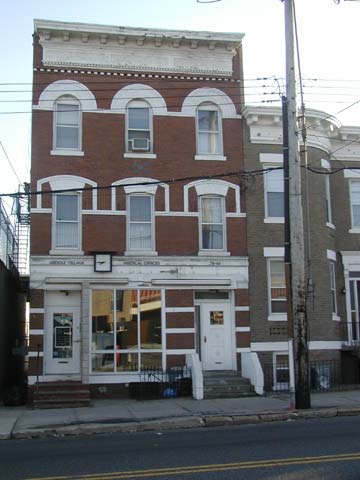
Met Ave. house marked ‘1913’.
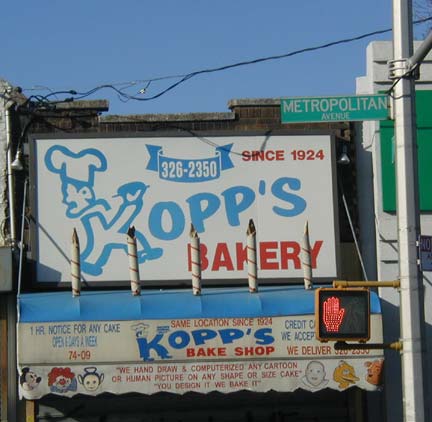
A Met Ave. institution, Kopp’s Bakery. Picture from 2004.
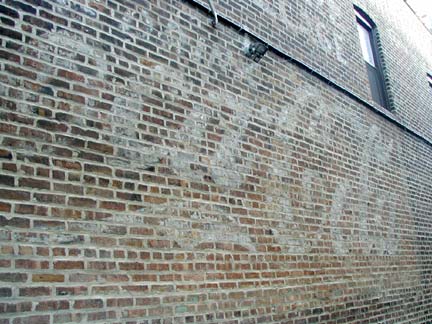
Ancient Coca-Cola ad near 73rd St. on Met Ave., and above, Juniper-Elbow pipe and watertight closure manufacturing company near 72nd St. “Elbows” are curved pipes used in furnaces and for other uses.
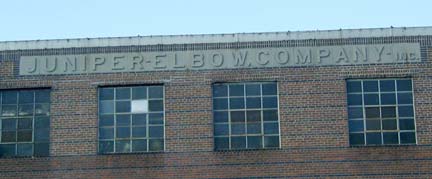
Off the Beaten Path
Having toured Middle Village’s largest commercial strip from one end to the other, we will now venture into the residential area.
During the 18th, 19th and (the early part of the) 20th centuries, the large marsh in the valley about a 1/2 mile north of Metropolitan Avenue was known as Juniper Swamp. ‘Juniper Round Swamp Road’ was a colonial path that skirted along the southern perimeter of the swamp. In 1915, the swamp was drained. By the 1920’s, residents had decided that the area’s name needed a bit of a facelift, so it was changed to Juniper Valley. Juniper Round Swamp Road then became Juniper Valley Road, part of which still exists today.
The following photos were taken in or around the Juniper Valley area…
Juniper Valley Park
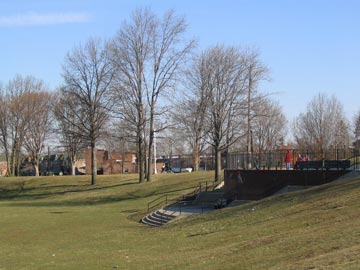
This was one place where American soldiers hid from the Redcoats after the British took Long Island in 1776. The swamp and surrounding area were blanketed by a thick forest of juniper and white cedar trees.
In the 1920’s, notorious gangster Arnold Rothstein (the man responsible for the 1919 Black Sox scandal) bought the swamp and attempted to sell it off in land parcels by erecting houses that were mere empty shells.
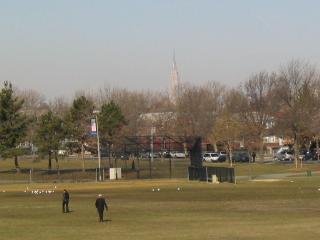
Before the current site of Juniper Valley Park was improved for recreational purposes, it was used variously as a farm, a cemetery, a garbage dump, and a source of peat moss. The peat taken from here was removed by squads of WPAworkers during the 1930’s and it was used by the city in parks and on highways. From 1941 to 1942, the WPA transformed the then barren land into one of Queens’ most beloved parks. The sloping landscape of the park reveals its past as a swamp. To this day, this part of Midville turns into Mudville after a rainstorm.
Pullis Farm Cemetery
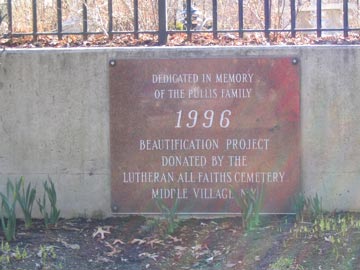
Thomas Pullis bought a 32-acre farm in Middle Village in 1822. He, his wife and at least one of his children were buried in a small plot of land on the farm. Other unknown family members are also thought to be buried here. In his will, Pullis prohibited the sale of the cemetery, and he left instructions to his three sons to build a brick wall around its perimeter to protect it.
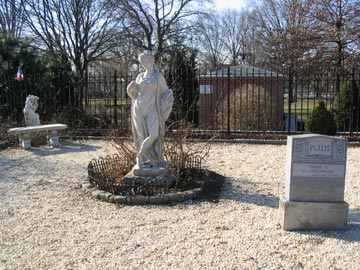
For years, the Pullis Farm Cemetery sat in Juniper Valley Park, unmarked and overgrown with weeds, but gated. In 1996, restoration of the graveyard was completed, with the addition of a new headstone donated by Lutheran Cemetery. The Pullis Cemetery is one of the few surviving farm burial grounds in New York City; its oldest known grave dates back to 1846.
Trinity Lutheran Church
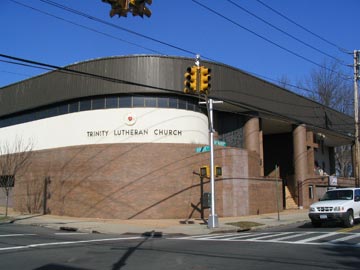
Trinity Lutheran Church on Dry Harbor Road was founded in 1851. The building, however, is obviously not quite that old. The church went through several incarnations before settling into this postmodern type of structure.
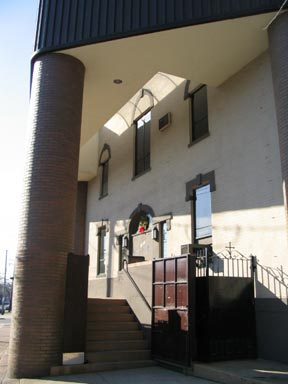
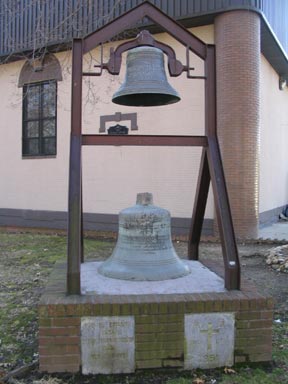
The bells and cornerstones are all that are left from the previous two churches, the first of which was located in Lutheran Cemetery.
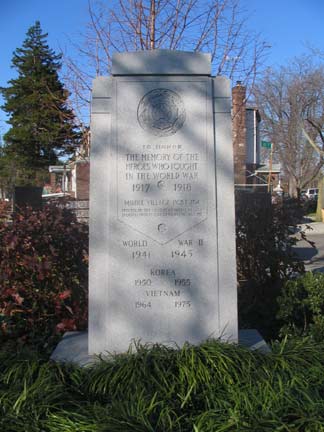
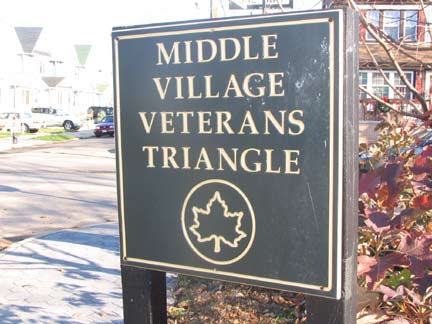
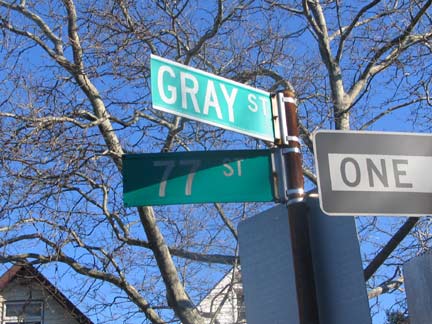
This park at Gray and 77th Streets honors the veterans of Middle Village who fought in World War I (1914-1918), World War II (1939-1945), Korea (1950-1953), and Vietnam (1964-1975). It features a large granite monument, erected by the citizens of Middle Village and the Property Owners’ Association of Middle Village Inc. It was originally erected to honor the men of Middle Village Post 784, who fought in World War I, and now honors all wartime servicemen.
Morrell House (RIP)
Thomas Morrell was one of the first settlers in the area. He came from the landed gentry of England and hoped to find a fortune here in America in 1663. He built this house, in a style called “saltbox architecture” in 1719 along what is today Juniper Valley Road. It was the last original house left standing along the colonial road.
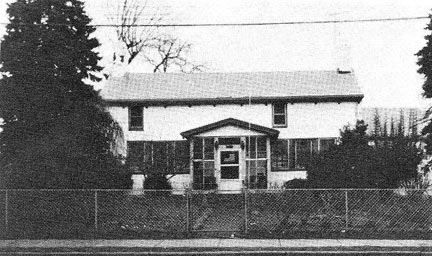
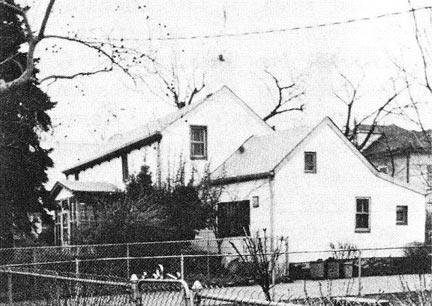
The house was lovingly taken care of by its subsequent owners until 1985, when it finally met the bulldozer. In an oft-repeated outer-borough tragedy, the Manhattan-centric NYC Landmarks Commission rejected pleas from the community to save it, even though it was verifiably one of the oldest structures in the entire city. This hideous twelve-unit dwelling took the one-family’s place.
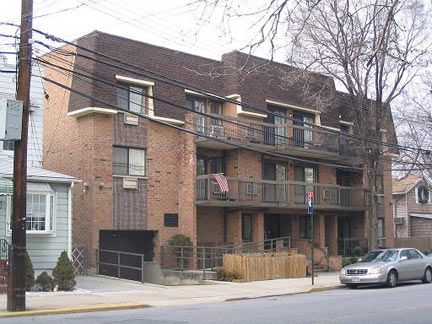
In 2005, the Juniper Park Civic Association won a lengthy battle with the city zoning commission, and this area along with the rest of Maspeth and Middle Village was finally rezoned to prevent more of this type of overdevelopment. Future construction will be required to be done in such a way as to preserve the character of the community, not run roughshod over it.
Photos from “Our Community, Its History and People: Maspeth, Middle Village, Glendale and Ridgewood,” Greater Ridgewood Historical Society, 1976.
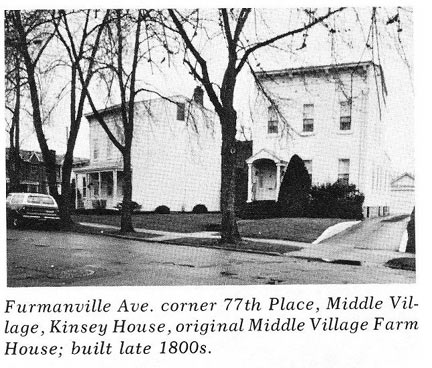
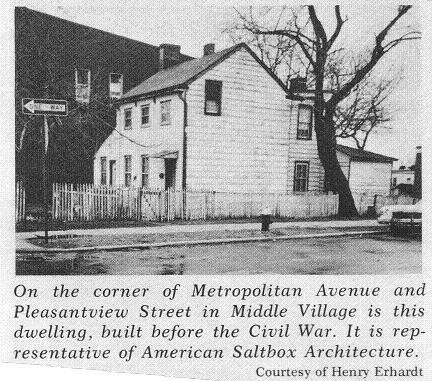
ABOVE: Kinsey House – demolished in 1996; Pleasantview Street house – demolished in 1986, replaced with 49-unit apartment building.Photos from “Our Community, Its History and People: Maspeth, Middle Village, Glendale and Ridgewood,” Greater Ridgewood Historical Society, 1976.
Furmanville Avenue farmhouse
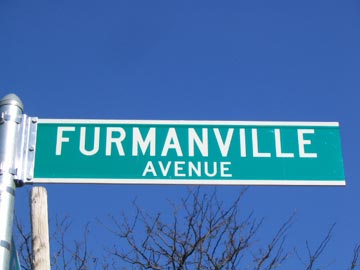
In 1759, Jonathan Furman settled in Middle Village (then part of Newtown) along Dry Harbor Road. The area surrounding his land soon became known as ‘Furmanville.’ The old colonial road that led to this part of town is still named in its honor.
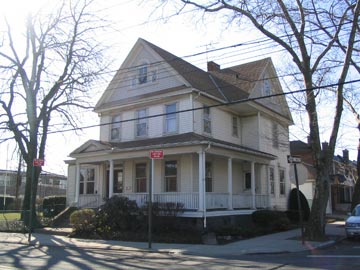
This old farmhouse on Furmanville Avenue dates back to the 1890s. At one time, it was surrounded by vast acres of farmland. Although no longer a working farm by the early part of the 20th century, ponies frolicked in the yard as late as the 1950’s.
St. Margaret’s
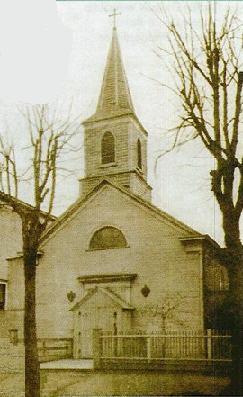
St. Margaret’s Roman Catholic Church was built in 1860 (above) on land once owned by Thomas Pullis. A school was built a few years later. During the Civil War, priests from St. Margaret’s administered to Rebel soldiers being held in a Metropolitan Avenue tavern serving as a makeshift jail.
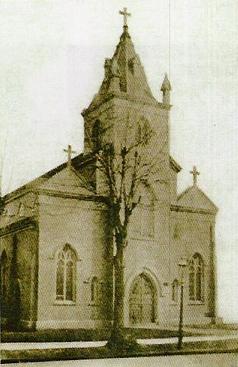
The church was rebuilt in 1907(above) and remains standing today, behind the current church building. The school was rebuilt in 1899. (photos left and above fromJuniper Berry)

The third version of the church was built in 1935.They decided on a rather efficient design the last time…the school is actually above the church, in the same building.
St. Margaret is the patron saint of farmers, appropriate considering the line of work of its first parishoners.
Our Lady of Hope
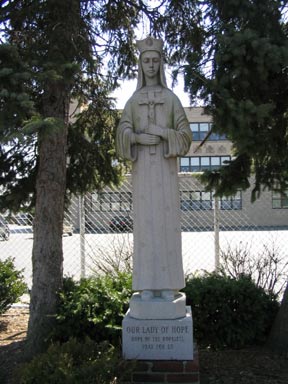
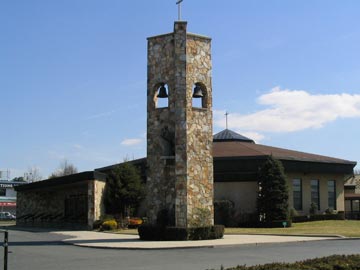
One hundred years after the founding of St. Margaret’s, Middle Village Catholics felt they needed another church.
The new Our Lady of Hope, with its distinctive hexagonal design and bell tower, was built on Eliot Avenue just north of the NY Connecting Railroad tracks about 1983. Here is a photo of the roof of the church under construction.Jewish Influence
In 1901, a group of wealthy German Jews living in Manhattan founded an organization to move poor Jews out of the crowded slums of the Lower East Side. Over the next 10 years, about 60,000 were resettled. Jewish-friendly realtors introduced them to Middle Village, which, with its open lands, must have seemed like paradise.
Hebrew Institute of Middle Village
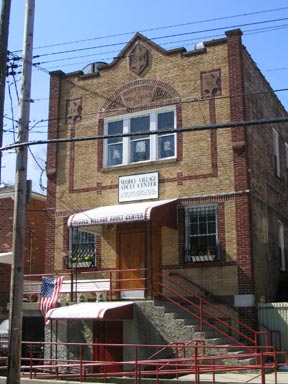
The structure which houses the the Middle Village Adult Center, on 75th Street, harkens back to the early 20th Century. Today the building serves as a senior center.
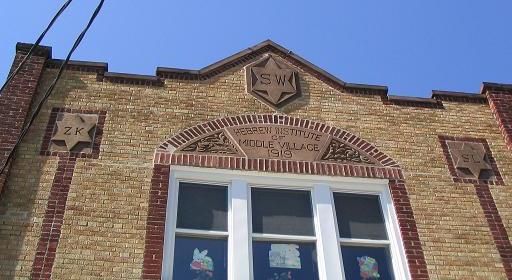
The top of the building reveals a hidden past. This was once The Hebrew Institute of Middle Village, a rabbinical seminary built in 1919. The first area synagogue, which dated from 1906 and next to which this was built, was torn down in the 1970’s. The letters inside the stars likely represent the initials of the schools founders or major donors.
Ahavath Achim Synagogue
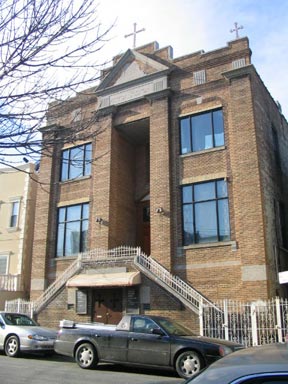
Tucked away on another side street, we find the Holy Archangels Michael & Gabriel Romanian Orthodox Church, which tends to the area’s most recent influx of immigrants. The church moved into this building in 1997.
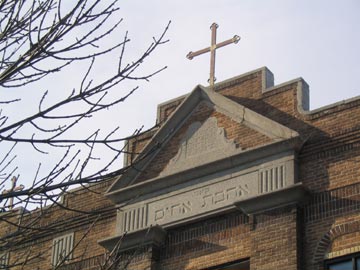
Examining the top of the church reveals something peculiar. The Ten Commandments and the words “Congregation of Brotherly Love (Ahavath Achim)” are inscribed in Hebrew above the entrance to the building, which was built in 1921. This was the second of the three orthodox congregations that flourished in Middle Village during the first half of the 20th Century.
Forest Hills West
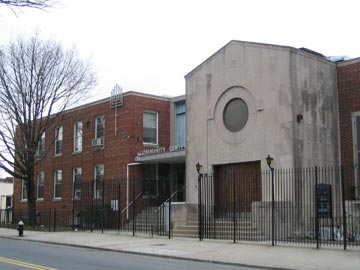
The Congregation of Forest Hills West is Middle Village’s last remaining synagogue. It was founded in 1935.
Forest Hills West? Hmmm… Middle Village was never called that to the best of our knowledge, and to get to this part of town from Forest Hills, one first has to traverse through Rego Park, so the reason for the name is a bit unclear. Maybe someone thought ‘Forest Hills West’ sounded really chic.
Most people here today are proud to call themselves Middle Villagers. The town grew in both population and land size when the area known as ‘South Elmhurst’ seceded from Elmhurst proper and officially became part of Middle Village in 2003. The debate over the pros and cons lasted for several years. Despite this, and, of course, the bureaucratic red tape, it finally did happen, though.
Having the last digit of their zip code changed from a 3 to a 9 made some people very happy.
More Middle Village photos here.
Sources:
Brooklyn Genealogy Information Page
Doug Leblang, Artist
History of New York State
Juniper Berry
Queens Tribune
Times Newsweekly
The Encyclopedia of New York City, by Kenneth T. Jackson, et al, Yale Univ Press, 1995
Special thanks to:
City Councilman Dennis Gallagher’s office for supplying back issues of the Juniper Berry
Doug Leblang for donating his photos and artwork
Mayer Spilman for the Hebrew translations
The above photos were taken on March 26th and 27th, 2005, and the page was completed on April 15th, 2005 (addition January 21, 2006) by Forgotten NY correspondent Christina Wilkinson.


50 comments
[…] Frank T. Lang is prominently displayed on the facade. Although it’s now an auto repair shop, Forgotten NY reveals that the 1904 structure was originally built by a mausoleum and monument manufacturer […]
I think you need to do a little research about your pictured posted as “Met Ave. house marked ’1913′.”
I can tell you that the address of that house is 78-44 Metropolitan Avenue. According to NYC Property Records, that building was not even built until 1930, so the photo could hardly have been taken in 1913.
Also I have been discussing this in a group on Facebook, and people who lived there are saying it looks more like the 1990’s. I do believe there is an air conditioner (but can’t be sure) in one of the upper windows … and as with the building itself … I don’t believe window air conditioners existed until long, long after 1913.
I would very much appreciate being informed of anything you learn about this photo and the actual date it was taken.
Thank you.
if you had read it properly it said it was marked 1913. Now it could have been a building there that was condemned and they used some bricks from it with the construction of the new building and it says nothing about when the picture was taken. So please with the snide remarks
I entered Christ the King as a Student in 1965 and the Train Station on Metropolitan Ave then looked like it did in 1906, I believe they renovated the station in the Late 70’s or Early 80’s
Thanks ever so much for your work on this. I was particularly glad to see the history of the Lutheran Cemetery where some of my German ancestors were buried. Since we still have my great-grandmother’s cemetery deed (first burial 1886, last burial 1960), I used your article and photos of the U.S. Crematory at the cemetery to finally figure out that she was cremated nearby at the U.S. Crematory–something that the records wouldn’t show. I’m also grateful for your window into a little-known sidelight of Kleindeutschland. I’m going to make the trip to Middle Village! Thanks for your good work!
I grew up in Middle Village during the 50’s and 60’s, attended St. Margaret’s and was a member of the first graduating class of Christ the King HS. Before CKHS was built the grounds were used to play Little League baseball. When they started building CKHS, they discovered an underground stream right beneath the building site. They had to rip out some of the original construction to add additional supports for the building resulting in the school delaying its occupancy for several months. The freshman class of 1962 were initially scattered among other Catholic high schools in Queens until the building was ready.
I too was a member of that first graduating class. For freshman year we went to Mater Christi HS in Astoria. What a trip to get from Ridgewood to there!
I also went to Mater Cristi, but did not transfer. Patricia Rubino Sandler
The Artistic Building was a monument store. The building to the East of it had a gantry for moving the granite slabs and the equipment for cutting and carving stones.
The link to the history for the Metro Mall no longer work. I don’t suppose you have it physically saved somewhere?
see this https://web.archive.org/web/20080705232117/http://www.timesnewsweekly.com/Archives2002/Jul.-Sept.2002/082202/NewFiles/OURNEIGH.html
A great walk down memory lane. I grew up in MV, and went to St.Margarets graduated in 63. The photos are great, places I remember and were part of my childhood.
Kopps Bakery, the butter cake was to die for! Juniper-Elbo, I would like a dime for every time I walked by the building. The Arion Movie Staurday afternoons, fantastic.
I have family buried in St. John’s and Lutheran Cemeteries. My great grandfather had hot houses on 69th St. and Juniper Valley Rd. A huge extended family now long gone or scattered to the 4 winds.
Nothing stays the same, changes happen but in my mind MV was a great place to grow up in and it will always be a fond memory!
The Artistic Building was a monument store. The building to the East of it had a gantry for moving the granite slabs and the equipment for cutting and carving stones.
Middle Village was a great place to grow up. Thanks for the comments by my brother, Thomas Strauch. I graduated SMS in 1967 and CK in 1971. Please remember that Christ the King was co-institutional, not
co-educational, until the school year 1071-72. My mother’s ENTIRE extended (Weis) family lived on Metropolitan Avenue, across from the cemetery, since the 1920’s. It was a group of 3 houses, including 7 apartments
which housed my great-grandmother Mary Weis and her 6 children and their families. There was a vacant lot next door, called Nanny Goat Hill (apparently someone in “olden times” kept a goat there. My brother and I use
to sled down the hill when we had snow. The lot was next to Bell’s Tavern, a favorite haunt of the Weis Brothers (my grandfather and his 4 brothers). Some of the family still lives in the remaining homes, but 2 of the
buildings were torn down in the ’80’s and replaced with condos. The location was particularly attractive as it went all the way back to the back street and allowed parking access for the condos. In the late 60’s, I worked in
both Jamron’s and Thrift’s, and at 14 I had a credit account at the women’s Schiendfeld’s, paid for with my babysitting money. Thomas, not only was the Kopp’s Butter Cake amazing, but their rolls, especially the ‘Snow on
the Mountain” ones were favorites of Mom and I. My great-grandfather, Fredrick Walter owned a florest business and greenhouses on 69th and the end of Juniper Valley (near PS 28), supplying the Lutheran cemetary. I
remember visiting the house and the greenhouses when I was very young. The greenhouses ran all the way back to the train tracks. The property was probably sold in the late 1950’s. The Walter family was related to the Neidersteins. In 1997, my husband opened an Allstate in the Metro Mall and owned the business for 10 years. It is now owned by a wonderful man, Kevin Spahn and is located on Dry Harbor Road. Great memories!!!
Joanne (Strauch) Wolter PS – I didn’t make a typo with the spelling of my name, it is Wolter with an “o”.
Thanks for the pictures and history. I spent many days in Middle Village, my family is in the cemetary there, and I ate at NIEDERSTEIN’S many, many, times. It has been years since I have been here, and wanted to eat there once again, and get a Kopp’s crumb cake. Iwould think new owners would capitalize on the history and returning customers instead of trying to start all over.
Anyway, thanks for the history, my son just moved back to NY, but he will not be able to enjoy these two great places. Wish I could on my visits, at least I was there before they were gone..
I enjoyed reviewing all the photos and the history as my home was in Middle Village from when I was two years old until I left to go to Texas A & M University I enjoyed my childhood here, enjoyed riding my bicycle, enjoyed meeting friends and talking with elders. It was a fun time with open fields next to Eliot Ave
Edward–Did you go to Resurrection-Ascension,Class of Feb ’53??
I was going to see my “Castle” (2nd one down, Harnishfeger”) it is onloy then that I realized missing
Neidersteins…it kind of brought a tear to my eyes…we went there for “every passing” of a relative,
brother, cousin, aunt. Sad to see an Arby’s there.
Yes the cemetery is kept well, the care giver is a genuinely nice person as well and cares about the grounds…Alberto?
Happy to know I will be there in my Castle, in the distant future!
Sincerely….
Our Lady of Hope Catholic Church was actually started in the early 1960’s. The church used a large tent to hold services. The tent church lasted over a year, until the current church was built. I remember my father getting a phone call one Sunday morning. It seems the tent had collapsed due to a snow storm and the pastor was calling the men of the parish, to help raise the tent so mass could be said that day.
Additionally, the area from 69th Street and Elliot Ave to where our Lady of Hope Church was used for Quonset Hut housing for returning WWII and Korean War veterans and their families.
I enjoyed seeing the picture of Kopp’s bakery. My great uncle Fritz Kopp started the bakery in 1924. My grandmother Clara Kopp Berg and my dad, Fred Berg worked there.
I remember grandma sending boxes of cookies to us in Connecticut for birthdays in the 1960’s. The stollen at Christmas time I miss, none compares!
My dad took us as kids to help fix the big oven one weekend. Happy memories.
I grew up in MV. My Grandfather went to Kopp’s, daily @ 6:00 am to get rolls. Their butter crumb cake and rye bread are still the best I’ve ever tasted.
I grew up in Middle Village in the 50’s through the 70’s. No matter where I live and have lived I still consider Middle Village my home.
I have many memories of Middle Village having grown up there. My brother, sister and I attended St. Margaret’s Church and School. Upon graduation in 1957 when I went to Brooklyn Tech HS. My brother also attended Brooklyn Tech and My sister graduated from Christ the King High School.
There was remains of an old tavern/rooming house on Metropolitan Ave next to he Methodist Church. As kids in the early 50’s, we played on the brick pile from this former building. A new Bohack supermarket was built on the brick pile site. An old cemetery located behing the Methodist Church contained gravestones from the 1700’s.
Kopp’s bakery used to donate their unsold bakery goods to St. Margaret’s Convent and also to the pastor of Lutheran church.
We used to visit the bakery after school and delivered the baked goods to St. Margaret’s Churchrectory and convent in a kids wagon.
Children from the Lutheran community did the same.
I later learned Confederate POW’s had been housed in the building during the Civil War.
I also grew up in Middle Village and attended St. Margaret Church and School and lived in the house next to Bohack supermarket. My gg-grandparents, John & Catherine Schneider, moved to Middle Village from NYC in the 1860s and purchased the tavern that housed the prisoners. However, I am not sure when they purchased it. It was called the Middle Village Hotel. Their daughter and son-in-law, Andrew and Catherine Seiz bought it from them and owned it from around 1890 until their deaths. At that time it was called the Brick Tavern. It was a tavern and rooming house. I have a picture of it taken in the 1930s – 1940s. When the law required all buildings to have indoor plumbing, it was too costly to make the change and my uncle, Joseph Seiz, had the building torn down. The bricks were then reused to build the large apartment building that stands directly behind this site. I see there is an earlier post from Andrew Dettling. Seeing his name made me remember my grandfather taking me to visit our Aunt Mary Dettling. Aunt Mary and my grandfather’s mother were sisters. I believe Aunt Mary lived on Pullis Avenue. I was a little girl at the time and she gave me a pretty ring. I remember what a sweet lady she was. I also remember Niederstein’s and Kopp’s Bakery. They were the best! Thanks for all the interesting posts. I enjoyed this trip down memory lane.
If your aunt was Mary Dettling, we are probably cousins. Mary was married to Charles Dettling. Charles was my Great Grandfather. I believe that my family is also related to the Seiz’s somewhere generations ago. Also, if your grandparents were Johann and Katherina Schneider (and your grandmother’s maiden name was Schafer), then our relatives share the same monument in St. John’s Cemetery. (Trivia: The plot is diagonally across the intersection from “Lucky” Luciano’s mausoleum.)
Just by chance I took a look at this message board and saw your reply. I am so glad you left this message. Yes, we are related. Your great grandmother, Mary Louise Schneider Dettling, and my great grandmother, Catherine Schneider Seiz, were sisters. Their father, Johann Schneider, was the first superintendent of St. John Cemetery and I know the monument you mention. It is where he is buried. I have been doing genealogy since 1976 and would be glad to share any of our family history with you. I have a picture of Johann Schneider and if you would like any of this information, my email is pegsto@rocketmail.com.
Grew up in MV and lived there after I married my wife from 1956 – 1994. A lot of fond memories there. Lived of 79th St. across from Charles Leonard’s factory down by the Cooper Ave. underpass. Remeber walking up to 80th St. to take the Q29 Triboro bus to Jackson Heights to go to Shea Stadium to go to the Mets & Jets games. Arion theater was the best. Rosa’s had the best pizza (sorry fans of Carlos’ pizza). Went to PS 87 then JHS 119 in Glendale then Grover Cleveland in Ridgewood. Rememer Flam’s department store and Kopps and the Jewish deli with those pastrami sandwiches! Nedierstiens with the sauerbraten which was good but never as good as my mom’s. The Italian bakery has the best pastries and bread anywhere.
WHO WERE THE O’BRIENS — I HEARD SOME TALES.
My sister who now lives outside of Albany sent me this information today. I still have a smile on my face after seeing the pictures and reading the comments. My mother lived in Middle Village all her life and I did until I
married in 1972. My two sisters were raised there as well but both have moved since. I live in San Diego now but always tell people about my childhood in MV. We lived down the street from the small park on 79th
Street and 69th Rd. Joseph C we lived in the same part of MV and went to the same schools. I took the Q29 day and night to go shopping, going to see friends in Rego Park, Elmhurst, etc. I do remember Flam’s departemt store. My Nana worked in Kopps Bakery for years and I still haven’t found a crumb cake to out do it, and I’ve lived in quite a few cities around the country. The Frank Lang building used to have a gas station under it and that’s where I filled up my car for $2.00 and drove all week. This has brought back really good memories and I appreciate all the work that was done.
Good memories and good times.
This is a real trip down memory lane. My parents owned the florist opposite the entrance to Lutheran Cemetery on Mount Olivet Crescent. Remembering the butter and crumb cake was wonderful and the Jewish deli (aka Willie’s) where we had a many pastrami sandwiches. I lived on Mount Olivet Crescent for 20 years before I moved to the Albany area and stayed for 45 years. Now I’m back in Brooklyn and I think a walking tour from the M station to the center of Middle Village would be a blast. Thanks to all that brought this memory together.
What happened to the flower shop? I live around the block and passing it when I’d walk would be so sad. Did they close of all and then it closed?
Enjoyed the pictures. Lived in Middle Village from 1941 to 1952. The Jewish Synagogue was on my street, 76th,
not 75th. Went to PS 87, and would sleigh ride on “Cemetary Hill”, two blocks away outside fence of Lutheran
Cemetary
After the comment following the Forest Hills WEST Jewish Center (area now M.V.), stated doubt
that the area was FHW, be it know that the area up to Dry Harbor Rd. was INDEED FOREST HILLS WEST early on. I live on 82 Place, rear to the Jewish Center and the original deed, street rendering (then Florence), architect plans and associated paperwork of my 1930 property says, Forest Hills
West. I am an original owner and proudly live in Middle Village.
Thanks for the memories! Used to buy our sweaters upstairs at the Frank T Lang building. So many memories return after seeing these photos. Born and raised in this beautiful town . Graduated St Margaret’s in 1966 and married there too. Stayed until 1984. Moved to Long Island but my heart will always be in “My Little Town”. Try not to change too much because in my mind you will always be a quaint town full of endearing memories. Only wished my children could have had the same experience.
I grew up in middle village and my family owned a bakery on 79 street across the street from the playground. It was open on sunday mornings and had delicious hot egg bagels and rolls among other breads. My older sister and i went to p.s.87. Then onto junior high school 119 and then grover cleveland high school. We enjoyed willies kosher delicassen and arion movie theater. We also use to frequent flams and scheinfelds.
Mimi
I grew up on 78 Street. My ancestors originally moved to MV in 1915 and both my grandfathers were shoe makers. I remember your family’s bakery very well. I indelibly remember the owners, the chubby gentleman carrying a tray of bagels on his yamulka’ed head, the flour all over him, the sweat rolling down his face. The incredible black bread for which I have never found a match, the cottage cheese raisin syrupy danish, the 5 cent bagels and rolls. I also went to PS87 and GCHS, probably a few years before you as that was when the schools were still 8/4 instead of 6/3/3. I hope you see this and hope that you might reach out to me pcmuzio@yahoo.com
God how I loved Middle Village. Moved there in 1950 and stayed there after I married. Moved in 2007 and miss it. Saw alot of changes though. My parents were married in St. Margaret’s in 1948 but at the time we lived in Richmond Hill and then moved to Middle Village. My mother was living with her sister on 79th Place. I went to resurrection Ascencion school. My kids went to Christ the King. It was a great neighborhood to grow up in. I used to go to Bauer’s bakery and when I was older John’s Bar on Dry Harbor. Good good memories. Tight neighborhood. Miss it dearly.
I grew up on Long Island and my grandmother lived in Middle Village at 69-14 66 Road. She lived there 1946 (maybe a few years earlier) through at least 1958. I have fond memories of Middle Village and her home, which is now demolished. If anyone has a picture to share of that address during that timeframe, I would love to see it again! Her name was Eugenie Tanguey Fletcher. My email is lizardnor@yahoo.com.
I grew up in Middle Village in the 1950-1960s. We belonged to the Jewish Center of Forest Hills West. We lived on 76StJust a few houses down from Juniper Valley Park. I went to PS 49 ES and PS 73 JH. Great place to grow up.
I lived on Penelope Ave between 80th and 81 st. I also went to 49 and 73.
I lived on 82 Place. My brother Ron and I went to PS 49, and he went to JHS 73.
Any information on the family Farms in the area my great great … Grandparents’ farms were there I just not exactly sure the latest deed I have from great grandparents Bohlets & Shoppman. House was 35 Caldwell on the deed. My uncle and mom sold property last year on 82nd Street. Have the dead from when great grandparents bought it in 1912 for 2k then transferred to grandma Cusick etc but don’t have much history about family before that Grandma was 3rd generation she had told me so trying to go back in history a little and figure out the family tree. Any help would be great.
Where might one get information on a Fire department that existed turn of the century in Middle Village,
the members called themselves “Fearless H&L Co. No 7” aka “Newtown Exempts”?
N.F.D June 1, 1911?
I can only tell you that that Firehouse was located at 71-55 Metropolitan Ave., just west of Pleasantview St. It operated between 1897-1916 and was afterwards used for various purposes, the last being rented rooms. It was demolished in the late 70’s and made way for the present day site of a large condo building. I do remember seeing an old b&w photo when it was still used as the firehouse, but sorry to say, I don’t recall where I saw it. Try the local historical societies or libraries for further information. Best of luck.
Does anyone remember the bowling alley on metropolitan ave in forest hills it was right next to car wash and abandon railroad tracks.
Yes, can’t remember the name but I bowled there many times.
Does anybody have any idea how to get hold of the old street names in Middle Village? For example, one of my aunts lived on Hosack Street, and my mother-in-law’s family bought a house on Henry Street.
https://stevemorse.org/census/changes/QueensChanges1a.htm
Does anyone know where I can find more of Doug Leblangs art? I’m looking for some of his other works, but not having much luck online.
Leblang is now deceased